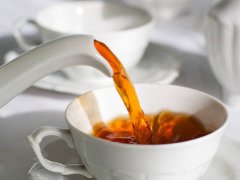What kind of tea is Dajinya tea? Big gold bud black tea taste characteristics Yunnan red lily and gold bud which is good
Dry leaf shape
The leaves are naturally curled, slender and tightly curled, and the buds show a point. If the quality is poor, the leaves are loose, rough and have no tip.
Dry leaf color
The leaves are golden and covered with fluff, and some buds contain black leaves. It looks shiny. When the quality is poor, the appearance of the leaf is dim and brown-black.
Law
High-quality tea consists of tea of fairly uniform size. If the quality of tea is poor, it will be mixed with many thick leaves, which are flat, loose and large. It is made of old leaves and contains a lot of fiber, which is difficult to roll into thin strips in the processing process. These leaves are lighter in taste and lighter in color when brewed. In addition, poor quality tea contains a large number of tea fragments, which are very light. This is due to improper handling and the finished product has not been well screened.
Cleanliness degree
Well-made tea must be free of fiber, bamboo or wood chips, sand or stone, dust and other impurities. Stems are inevitable because leaves are picked in the summer, but must be kept to a minimum, such as a few per gram.

Aroma
Dried leaves give a sweet smell of syrup. When brewed, this tea will give off the same fragrance. After brewing, the aroma remains on the leaves.
The color of the tea
When brewed, the tea produces a glossy and bright reddish brown. In the cup, it glows, and a bright gold ring appears near the edge of the cup. Jinhuan said that tea is rich in theaflavins, which is very important to the quality of tea. The tea of poor quality has a dark red color and a dim appearance.
Taste
Smooth, mellow, slightly sweet aftertaste, not spicy.
Moist leaves
It shows a bright reddish brown, very consistent and uniform leaves, indicating good quality and well-made tea. Touch with your fingers, soft and elastic. If the quality of the tea is poor, the color of the tea is a mixture of green-brown and red. It is mixed with mature leaves and is budding. In addition, green spots appeared on the leaf surface, indicating insufficient oxidation. The leaves look dull and the color is very dark.
Important Notice :
前街咖啡 FrontStreet Coffee has moved to new addredd:
FrontStreet Coffee Address: 315,Donghua East Road,GuangZhou
Tel:020 38364473
- Prev

Is it sweet to drink coffee with milk and sugar? How to make coffee sweeter and better
I first knew the coffee was in the TV series, the protagonist came to the hotel, used to place a cup of black coffee, habitually poured into two packets of sugar, skillfully stirred. This is the impression that many people feel about coffee. Coffee can be sweet without sugar now, you can even hear it, a friend who drinks black coffee will be shocked, this cup of coffee is so sweet! But this is sweet.
- Next

What kind of tea is the golden bud? how much is the golden bud tea? the brewing method of a jin of Jinsidian black tea.
The recommended method of brewing black tea is suitable for porcelain or glass teapots and teacups. It is recommended to use a transparent glass teapot to appreciate the process of brewing tea in water. Make tea in soft water. Hard water is not suitable for drinking, because it contains high minerals, which will inhibit the extraction of substances from tea, making the taste of tea very flat and thin, making it difficult to taste the real taste of tea. Put the teapot and teacup
Related
- Beginners will see the "Coffee pull flower" guide!
- What is the difference between ice blog purified milk and ordinary milk coffee?
- Why is the Philippines the largest producer of crops in Liberia?
- For coffee extraction, should the fine powder be retained?
- How does extracted espresso fill pressed powder? How much strength does it take to press the powder?
- How to make jasmine cold extract coffee? Is the jasmine + latte good?
- Will this little toy really make the coffee taste better? How does Lily Drip affect coffee extraction?
- Will the action of slapping the filter cup also affect coffee extraction?
- What's the difference between powder-to-water ratio and powder-to-liquid ratio?
- What is the Ethiopian local species? What does it have to do with Heirloom native species?

